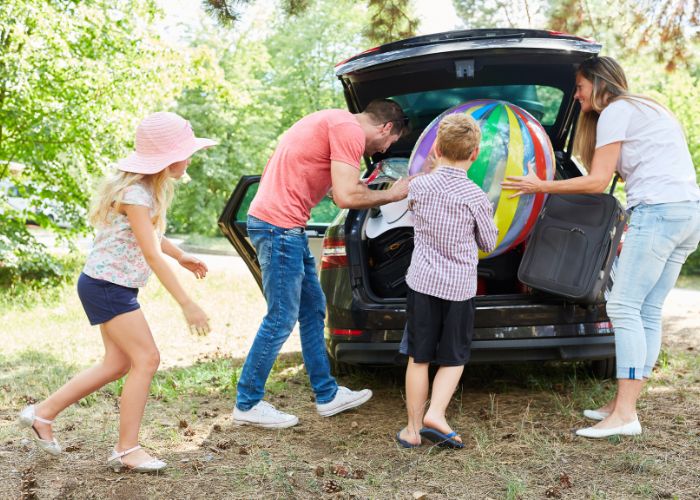It´s that time of year, and many of us have made the decision to “staycation”. To enjoy your summer holiday to the full, it is important that you have everything organised for your road trip. Here are some tips to help you stay safe and enjoy your vacation.
Spain is full of wonderful and interesting places to visit. You may be going by car for a beach holiday, a city break, or a route through the mountains.
July and August are the months when most long-distance road trips are taken. According to the DGT, last summer, there were almost 91 million trips. Furthermore, this year it is expected to exceed that figure. Especially with so many planned airline strikes, and staff shortages at airports.
Also keep in mind that short-distance trips are increasing, especially on secondary roads, and that there is a greater presence of cyclists and pedestrians on the road.
Top tip: Do not announce your holiday plans all over social media. Especially if your property is going to be empty.
"Pasando unos días en la playa"
👀 A 40 ladrones cerca de tu casa les encanta ♥ tu post
"Si vas de vacaciones cuida tus publicaciones"#VeranoSeguro2022🌅 pic.twitter.com/uA0Q1mmQpE— Guardia Civil 🇪🇸 (@guardiacivil) July 1, 2022
When is the best time to travel?
Fridays tend to be when the traffic is busiest, and Tuesdays the least. Also consider various ferias and local holidays throughout your route as these may mean more traffic.
The worst time on a Friday is usually between 3.00 pm and 11.00 pm. Saturday mornings and Sunday afternoons are also busy. This is especially true around large cities, where many may be travelling for the weekend.
In terms of areas that could cause traffic delays, the main problems are at the exit points of cities, and the main access roads to coastal areas. The roads normally most affected are around Madrid, Castilla la Mancha, Valencia, Murcia and Andalucia.
Safe driving
No-one wants to get stopped and fined or have an accident especially enroute to your annual holiday. Therefore, it is important to respect the rules of the road;
- Always keep a safe distance from the vehicle in front of you
- Do not drink alcohol if you are going to drive and if someone in the group has done so, it is your responsibility not to let them drive.
- Turn off the mobile or put the car mode on those devices that incorporate it. If you go as a passenger, do not let the driver manipulate the mobile or the browser.
- Wear the seat belt properly fastened and check that the rest of the occupants of the vehicle also do so.
- If minors travel, they should always use a child seat suitable for their size and weight.
- Stop every 2 hours to rest.
Plan
It is a good idea to consider the above tips. Therefore, planning your route and stops is vital. There is nothing worse than being stuck in traffic for hours if that could have been avoided. You can also check out which route you prefer to take and plan your stops along the way.
Also read: Summer holidays in a Motorhome
Luggage
Empty your car of anything unnecessary for your trip. Pack your cases well, with the heaviest items to the bottom and centre of your boot area. There should be anchor point in your boot where you can tie the luggage down to prevent it from moving.
Top Tip: If there are no passengers in the back, or any empty seats, it is a good idea to fasten the seatbelt. This way, in the event of an accident, the luggage will be prevented from entering the passenger area.
Documents
It is important that all your documents are in order, and up to date. This includes your insurance and ITV, but also the annual registration tax.
Emergency items
You must ensure reflective vests go in the car, as they must be worn in the event of an accident or break-down. Also, the warning triangles (or V-16 emergency light) must be in the vehicle.
It is advisable to take an extra set of car keys with you on a long trip. These should be carried by another member of the family.
Travel clothes
Wear light clothing that does not hinder your movements. Have comfortable shoes that do not prevent you from manoeuvring well with your feet on the pedals. Therefore, it is “advisable” not to wear flip-flops or heels. If you wear glasses, it is also “advisable” to have a spare pair in the car. It is also advisable to wear sunglasses to avoid glare and fatigue caused by prolonged exposure to sunlight.
Pets
If you are taking your four-legged friend with you, it must be well restrained. This would be either in a carrier, with a harness, or with a seatbelt. It is important that the pet must not be a distraction for the driver.
As stated by the DGT, if your animal is not properly fastened in a range of 60km/h, a 4kg pet would hit the windscreen with the equivalent force of 225kg.
Temperature
Expert advice from the DGT says the ideal vehicle temperature should range from 21 to 23 degrees. Anything higher can cause drowsiness. Different studies indicate that above 23ºC 3% of the signs are not seen, and above 35ºC the driver presents symptoms like those he would have with a blood alcohol level of 0.5 milligrams.
Also read: These tips will help you avoid a fine when driving in Spain


